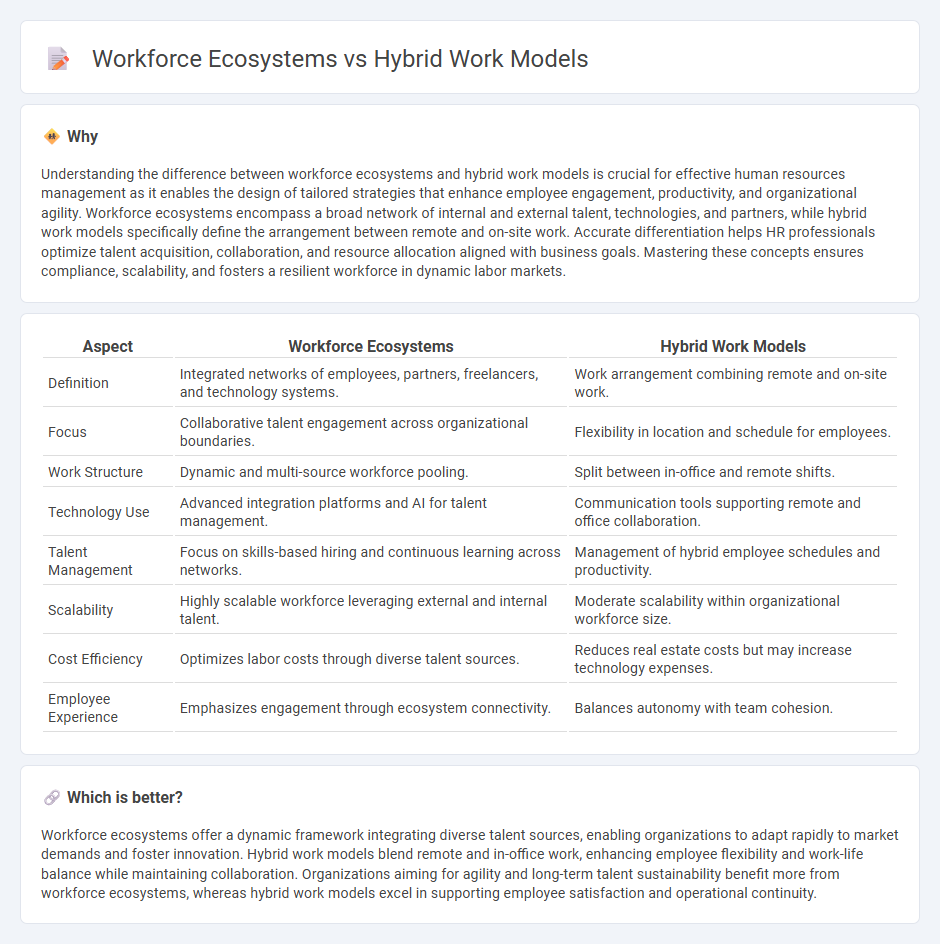
Workforce ecosystems involve interconnected networks of employees, technology, and external partners that drive organizational agility and innovation. Hybrid work models blend remote and on-site work arrangements to enhance flexibility and employee satisfaction while maintaining productivity. Explore how these evolving strategies shape the future of Human Resources and workforce management.
Why it is important
Understanding the difference between workforce ecosystems and hybrid work models is crucial for effective human resources management as it enables the design of tailored strategies that enhance employee engagement, productivity, and organizational agility. Workforce ecosystems encompass a broad network of internal and external talent, technologies, and partners, while hybrid work models specifically define the arrangement between remote and on-site work. Accurate differentiation helps HR professionals optimize talent acquisition, collaboration, and resource allocation aligned with business goals. Mastering these concepts ensures compliance, scalability, and fosters a resilient workforce in dynamic labor markets.
Comparison Table
| Aspect | Workforce Ecosystems | Hybrid Work Models |
|---|---|---|
| Definition | Integrated networks of employees, partners, freelancers, and technology systems. | Work arrangement combining remote and on-site work. |
| Focus | Collaborative talent engagement across organizational boundaries. | Flexibility in location and schedule for employees. |
| Work Structure | Dynamic and multi-source workforce pooling. | Split between in-office and remote shifts. |
| Technology Use | Advanced integration platforms and AI for talent management. | Communication tools supporting remote and office collaboration. |
| Talent Management | Focus on skills-based hiring and continuous learning across networks. | Management of hybrid employee schedules and productivity. |
| Scalability | Highly scalable workforce leveraging external and internal talent. | Moderate scalability within organizational workforce size. |
| Cost Efficiency | Optimizes labor costs through diverse talent sources. | Reduces real estate costs but may increase technology expenses. |
| Employee Experience | Emphasizes engagement through ecosystem connectivity. | Balances autonomy with team cohesion. |
Which is better?
Workforce ecosystems offer a dynamic framework integrating diverse talent sources, enabling organizations to adapt rapidly to market demands and foster innovation. Hybrid work models blend remote and in-office work, enhancing employee flexibility and work-life balance while maintaining collaboration. Organizations aiming for agility and long-term talent sustainability benefit more from workforce ecosystems, whereas hybrid work models excel in supporting employee satisfaction and operational continuity.
Connection
Workforce ecosystems integrate diverse talent pools, technology platforms, and organizational structures to support hybrid work models that combine remote and on-site collaboration. This interconnected approach enhances flexibility, employee engagement, and productivity by leveraging digital tools and flexible work arrangements across various environments. Effective management of these ecosystems requires aligning HR strategies with technological enablement and cultural adaptability to sustain a resilient and agile workforce.
Key Terms
Flexibility
Hybrid work models emphasize flexibility by combining remote and in-office work to accommodate employee preferences and optimize productivity. Workforce ecosystems expand this flexibility by integrating diverse talent sources, including freelancers, contractors, and partners, creating a dynamic and scalable organizational structure. Explore how these approaches redefine flexibility and drive business agility in modern workplaces.
Collaboration
Hybrid work models emphasize flexible work arrangements by combining remote and on-site collaboration, optimizing productivity and employee satisfaction. Workforce ecosystems extend beyond traditional models by integrating diverse talent pools, technology platforms, and partners to create dynamic, interconnected collaboration networks. Explore how these approaches redefine teamwork and drive innovation in modern organizations.
Talent Integration
Hybrid work models enhance talent integration by combining remote and on-site collaboration to boost productivity and employee engagement. Workforce ecosystems expand this concept by fostering interconnected relationships among employers, technology platforms, and external talent pools to optimize skills and innovation. Explore how integrating hybrid work models within workforce ecosystems can transform talent strategies and drive organizational success.
Source and External Links
What is hybrid work and what are hybrid work models? - Webex - Hybrid work blends in-office, remote, and mobile work, with four common models: flexible (employees choose work location/time), fixed (set remote/in-office days by employer), among others, each with distinct benefits and challenges such as increased flexibility versus scheduling difficulties.
17 Hybrid Work Model Examples To Inspire You in 2025 - AIHR - Examples include fixed onsite days where companies mandate office presence on specific days, and full autonomy allowing employees total freedom to decide when and where to work, supporting diverse approaches depending on company needs and culture.
What is hybrid work and why is it so popular? - Zoom - Hybrid work provides flexibility by mixing remote and in-office time, improving employee satisfaction and reducing costs; flexible models emphasize autonomy and trust, while fixed models provide structure to foster collaboration.
 dowidth.com
dowidth.com